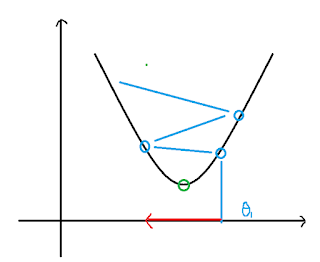[Ex]
\begin{array}{llll}
\hfill\mathrm{Size~in~feet^2 (x_1)}\hfill &
\hfill\mathrm{\#~bedrooms(x_2)}\hfill &
\hfill\mathrm{\#~ floors(x_3)}\hfill &
\hfill\mathrm{Age(x_4)}\hfill &
\hfill\mathrm{Price~$1000~(y)}\hfill
\\ \hline
\\ 2104 & 5 & 1 & 45& 460
\\ 1416 & 3&2&40&232
\\ 1534 & 3&2&30&315
\\ 852 & 2&1&36&178
\\ ... & ...& ...& ...& ...
\\ \end{array}
Notation:
- n = number of variables
- m = number of examples
- \(x^{(i)}\) = input variables of \(i^{th}\) training example.
- \(x^{(i)}_j\) = value of input variable j in \(i^{th}\) training example.
Hypothesis: \( h_\theta(x) = \theta_0 + \theta_1 x_1 + \theta_2 x_2 + \theta_3 x_3 + \theta_4 x_4\)
For convenience of notation, define \(x_0 = 1\), it means \( x^{(i)}_0 = 1\), so the hypothesis can transfer as:
$h_\theta(x) = \theta_0 x_0 + \theta_1 x_1 + \theta_2 x_2 + \theta_3 x_3 + \theta_4 x_4 $
$ = \theta^T x $
So, the definition is as below:
[Def]
$$\begin{align*}& \text{repeat until convergence:} \; \lbrace \newline \; & \theta_j := \theta_j - \alpha \frac{1}{m} \sum\limits_{i=1}^{m} (h_\theta(x^{(i)}) - y^{(i)}) \cdot x_j^{(i)} \; & \text{for j := 0...n}\newline \rbrace\end{align*}$$
So, the definition is as below:
[Def]
$$\begin{align*}& \text{repeat until convergence:} \; \lbrace \newline \; & \theta_j := \theta_j - \alpha \frac{1}{m} \sum\limits_{i=1}^{m} (h_\theta(x^{(i)}) - y^{(i)}) \cdot x_j^{(i)} \; & \text{for j := 0...n}\newline \rbrace\end{align*}$$



